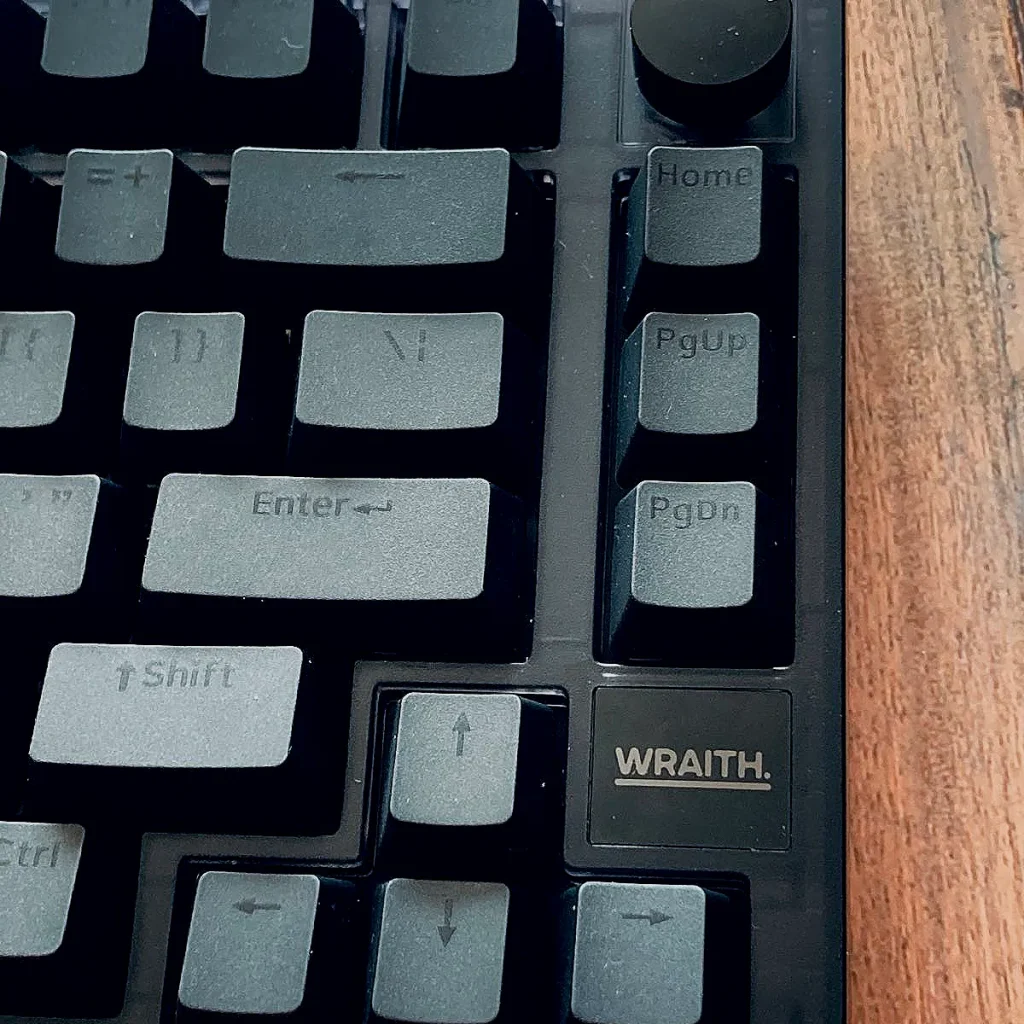The W75 is a magnetic keyboard from Turkey, marking the brand’s first step into Hall Effect technology. It’s a quiet keyboard that stays discreet, especially in the dark where it’s nearly invisible, while still delivering solid quality. In this review, we’ll explore its magnetic switches, understated design, and overall performance to see how it measures up. And find out why the review title stands true.
Disclaimer: this unit was sent out to me for testing purposed, however, Wraith Esports and AceGear.pl had no influence on this review.
In the Box
- W75 Magnetic Keyboard
- braided USB-A to C cable
- three spare Gateron KS-20 dual rail switches
- manual
- keycap/switch puller
Bottom line? Standard but meagre content inside, the manual is less than basic.
Specs
The scanning rate is 1k, so it’s not the real 8k.
Bottom line? Not the real 8k, but dual-rail switches are nice.
Design and Build Quality
The Wraith W75 V2 is an 81 keys/75% magnetic keyboard that stands out with its futuristic design in Stealth Black, giving it a modern and unique character and have to say I really like it.
The keyboard is designed with a gasket mount, ensuring exceptional stability, vibration reduction, and a pleasant tactile experience while typing. The Wraith W75 V2 also features “screw-in” stabilizers, further enhancing typing comfort. The keyboard is also equipped with an elegant aluminum knob, enabling easy and quick multimedia control.
Material used is ABS plastic, the keyboard is gasket mounted with foams under PCB and in between. It features also adjustable feet and silicon paddings in the rear and a transparent bottom case. The feet don’t fold down when pushed across the desk. The knob is a bit loose though but the keycaps look really nice, giving this elegant feeling of a dark keyboard.
Bottom line? A nice futuristic design with transparent bottom, nicely looking keycaps, good gasket-mount feel.
Keycaps
When it comes to the keycaps of the Wraith W75 magnetic keyboard, I’ve got a bit of a bone to pick — but it’s not about the usual suspects. It’s not the ABS material they’re made of; that’s perfectly fine by me. Nor is it their thickness, which feels solid and well-crafted. The texture? Grippy and comfortable, no complaints there. Even the small shine they develop after some use doesn’t bother me — it’s a natural patina, almost charming in its way. No, my issue lies with their color. These keycaps are an oppressively dark, dark, dark brown, paired with a black legend that might as well be invisible. They’re non-shine-through, which I get is a deliberate choice — maintaining that sleek, stealthy blacked-out aesthetic for those who crave a cohesive dark setup. But for me? It’s almost a deal-breaker.
In a dimly lit room, they’re unreadable. In daylight, I’m still squinting to make out the letters. I can see the vision behind it, sure — form over function for the minimalist crowd — but it’s impractical for daily use. If they were shine-through, this would be a different story entirely; a little backlighting could’ve saved the day. Now, I know swapping them out is an easy fix, and trust me, I did just that. But when I’m reviewing the stock product, like with my Stealth version of the W75, this color scheme becomes a real hurdle. Aesthetics are great, but legibility matters too, and these keycaps just don’t strike the right balance for me.
Bottom line? All good with keycaps but you must be aware they’re very dark and don’t let the shine through making them almost unreadable even in daylight. They are so quiet but barely noticeable — hence, I was feeling like I was “whispering in the shadows.”
Switches

They are quite light, well-lubed, with a pleasant feel when in use. One of the earliest magnetic switches, pretty stable due to dual-rail structure. I’ve used them before in one of Irok’s early magnetic boards. They felt pretty light there, they are light now (but the keycaps can change it a bit), I have nothing to complain about.
Bottom line? Light, stable, reliable.
Typing Experience and Sound Test
Check yourself in this first impressions video what W75 feels and sounds like.
Bottom line? Quiet, and good typing experience, yet, for some longer sessions a wrist rest felt handy in my case.
Software
When it comes to magnetic keyboards like the Wraith W75, the software is arguably the beating heart of the experience. It needs to be web-based (ideally), intuitive, user-friendly, packed with advanced features for gamers, and consistently updated. Unfortunately, the OEM software for the W75 doesn’t quite hit the mark. The UI is clunky and unintuitive, making navigation feel like a chore. Then there’s the bizarre vocabulary — SOCD (Simultaneous Opposite Cardinal Directions) is inexplicably labeled as “PRCS” for reasons I can’t fathom — and some of the translations are downright odd. Another glaring omission? No dead zone customization. Wraith claims it’s fixed at 0.1 mm and calls it a day, but for a keyboard touting precision, that’s a letdown.
On the flip side, it’s not all bad. The software does deliver on some essentials: you can set up DKS (Dynamic Keystroke), Mod Tap, and other advanced functions, remap keys, tweak RGB lighting, adjust polling rates, calibrate the keys, and configure Rapid Trigger and macros. It’s got the bones of a decent program. But here’s a kicker — every time you want to save your profile, you’re forced to navigate to the “Keymap” section and click a “Download” button tucked away in the bottom right corner. Why not a simple “Save” option? It’s a baffling design choice that grates on me. All told, I can’t call this software good — it’s a mess, frankly. For a keyboard with so much potential, the software feels like a half-baked afterthought that desperately needs a rethink.
Bottom line? Software is half-baked and needs a lot of improvement.
Latency and Gaming Performance
When it comes to latency and in-game performance on the Wraith W75 magnetic keyboard, there’s a mixed bag to unpack. On paper, its overall latency isn’t quite up there with the top-tier players in the industry. The culprit? A combination of inconsistent Rapid Trigger implementation and the absence of an 8k scanning rate. While it boasts an 8k polling rate, the keyboard scans at 1k, which puts it a step behind the cutting-edge competition. We’re talking about a difference of just a few milliseconds per keypress — nothing game-breaking for most — but it’s enough to notice if you’re used to the snappiest setups out there. That said, this slight lag wasn’t the real thorn in my side.
What stood out more was the Rapid Trigger functionality — or rather, its inconsistency. I experimented with tweaking the actuation point and Rapid Trigger settings, shifting from 1 mm down to 0.1 mm, and honestly? It barely made a dent in the feel. I’d hoped for a razor-sharp, responsive snap, but the execution felt off — like the Rapid Trigger was working, technically, but not delivering the crisp precision I’d expected. It wasn’t as snappy as the hype suggested, and that inconsistency dulled the experience a bit. Still, this was the only genuine gripe I had while gaming. Beyond that hiccup, I genuinely liked and enjoyed the W75. The overall feel, the satisfying magnetic switches, and the build quality? Those kept me hooked, even if the latency tuning left me wanting a little more.
Bottom line? Really decent, but not the fastest runner out there, with some Rapid Trigger issues.
Summary
In closing, the Wraith W75 magnetic keyboard offers a solid option for those seeking a reliable and stylish input device. Its sturdy build quality, eye-catching design, and stable switches contribute to a very good performance in games, making it a dependable choice for us all. While the real 8k polling rate might tempt some to look elsewhere, they’d be overlooking the fact that we’re firmly in “diminishing returns” territory with the magnetic keyboard arms race — more isn’t always meaningfully better.
Personally, I found the very dark keycaps a bit of a drawback, as they can be hard to read in certain lighting, though for anyone chasing a sleek, minimalist blacked-out aesthetic, they’re a perfect fit. The typing feel and sound are genuinely awesome, but without a wrist rest, long sessions can get tiring. The software, unfortunately, is a weak point — clunky translations and a rough UI make it feel unfinished, and there’s a noticeable dead zone that could use refinement. And honestly, I don’t think all those quirks will be fixed in the near future, if ever (I’ve reviewed too many keebs now, so I can see the writing on the wall).
Bottom line? W75 is a very decent keyboard that performs admirably and looks great, provided you can live with those ultra-dark keycaps and that inconsistent Rapid Trigger and a bit weird software.
Bullet Points
- very decent build quality
- Gateron’s dual rail KS-20 switches have a great feeling in games and everyday use
- very well-sounding keyboard
- typing feeling is decent, but can be tiring without a wrist rest in the long run
- pretty unique look with a transparent bottom
- software is OEM, needs a lot of work and translation fixes
- …but it works well, even though it’s unintuitive
- very dark keycaps so it’s very hard to spot legends in the dark, even though their quality is good
- noticeable dead zone of the switches even though it’s marketed as only 0.1mm
- inconsistent Rapid Trigger with difference barely noticeable between different values
You can get this keyboard at acegear.pl
Disclaimer: this review is not a paid endorsement. I want to ensure transparency and let you know that I am not receiving any compensation, monetary or otherwise, for evaluating or discussing this tech product.













